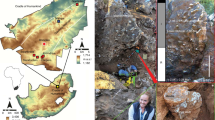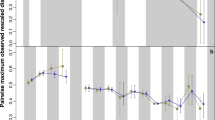Abstract
I SHOULD like to make a few points arising from the previous letter1. Much of the debate centres around the problem of species in palaeontology; how to define these, and how to assign new specimens to their appropriate taxon2. It is obvious that “the specimens representing the species make up the statistical universe”. The point which Wolpoff ignores is the manner in which individual specimens are assigned to “species”. In classifying fossils, due attention must be paid to variation within and between infraspecific populations, as well as to possible variation due to time2. The most important issue to decide in the evaluation of a new find is the species lineage (that is, a sequence of ancestral/descendant species populations) to which it belongs, and this requires some consideration of position with respect to infraspecific lineages (infraspecific lineages being sequences of ancestral/descendant infraspecific populations which are not isolated from others but which do have some time duration). Only when this decision has been made ought attention to be turned to classification at the species level, that is, to dividing up the evolving continuum and giving the arbitrary divisions binomina.
This is a preview of subscription content, access via your institution
Access options
Subscribe to this journal
Receive 51 print issues and online access
$199.00 per year
only $3.90 per issue
Buy this article
- Purchase on Springer Link
- Instant access to full article PDF
Prices may be subject to local taxes which are calculated during checkout
Similar content being viewed by others
References
Wolpoff, M. H., Nature, 227, 747 (1970).
Simpson, G. G., Principles of Animal Taxonomy (Columbia Univ. Press, 1961).
Howell, F. C., Amer. J. Phys. Anthrop., 27, 95 (1967).
Holloway, R. L., Science, 168, 966 (1970).
Tobias, P. V., Olduvai Gorge, 2 (Cambridge Univ. Press, 1967).
Howell, F. C., Nature, 223, 1234 (1969).
Simons, Elwyn L., Pilbeam, David, and Ettel, P. C., Science, 166, 258 (1969).
Tobias, P. V., S. Afr. J. Sci., 64, 81 (1968).
Robinson, J. T., in Evolutionary Biology 1 (edit. by Dobzhansky, T., Hecht, M. K., and Steere, W. C.), 69 (Appleton Century Crofts, New York, 1967).
Author information
Authors and Affiliations
Rights and permissions
About this article
Cite this article
PILBEAM, D. Early Hominids and Cranial Capacities (continued). Nature 227, 747–748 (1970). https://doi.org/10.1038/227747b0
Received:
Revised:
Issue Date:
DOI: https://doi.org/10.1038/227747b0
Comments
By submitting a comment you agree to abide by our Terms and Community Guidelines. If you find something abusive or that does not comply with our terms or guidelines please flag it as inappropriate.



